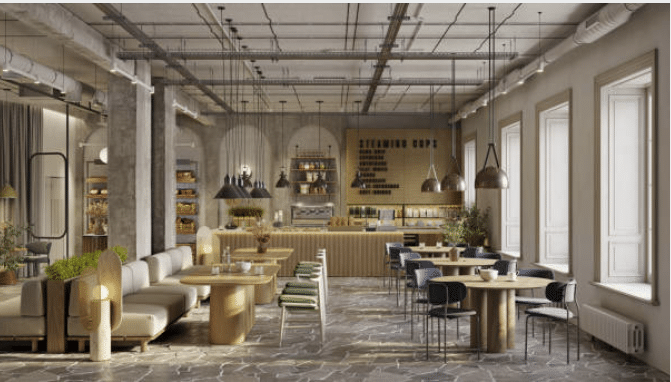
Restaurant furniture plays a crucial role in defining the overall ambiance and functionality of your dining space. It not only enhances the aesthetics of your establishment but also impacts customer comfort and experience. High-quality restaurant furniture can create a welcoming atmosphere, encouraging customers to stay longer and return frequently.
Additionally, well-selected pieces contribute to efficient space utilization, improving staff mobility and service flow. Investing in durable and stylish furniture ensures that your restaurant maintains a professional look while withstanding daily wear and tear. Selecting the right restaurant furniture is essential for establishing your brand identity and ensuring long-term profitability.
Key Factors to Consider When Choosing Restaurant Furniture
When selecting restaurant furniture, several key factors must be considered. First, durability is paramount; furniture should be able to withstand heavy use without compromising comfort. The material of the furniture should align with your restaurant’s theme and functionality.
Comfort is another critical factor, as customers are more likely to enjoy their dining experience in well-designed seating. Additionally, space efficiency is vital—choosing the right sizes and layouts ensures smooth traffic flow for both guests and staff. Lastly, budget constraints must be balanced with quality. Opting for high-quality restaurant furniture within your budget will save costs on frequent replacements and repairs.
Best Materials for Durable and Long-Lasting Restaurant Furniture
The longevity and durability of restaurant furniture depend heavily on the materials used. Wood is a classic and sturdy choice that adds warmth to any dining setting but requires regular maintenance. Metal furniture, such as stainless steel or aluminum, offers excellent durability and modern aesthetics, making it ideal for high-traffic restaurants.
Plastic furniture is lightweight, budget-friendly, and easy to clean, making it suitable for casual dining spaces. Upholstered furniture provides superior comfort but should be made of stain-resistant and easy-to-clean fabrics. When selecting restaurant furniture, consider the material’s ability to endure daily use while maintaining its appearance and functionality.
How to Match Restaurant Furniture with Your Brand Aesthetic
Your restaurant furniture should align with your brand’s identity and theme. If you run a fine dining restaurant, opt for elegant, upholstered chairs and polished wooden tables to create a luxurious ambiance. Casual dining establishments may benefit from vibrant colors and mixed materials, such as wood and metal.
Industrial-style restaurants often feature minimalist furniture with exposed steel frames and rustic wood finishes. The color palette of your restaurant furniture should complement the overall decor, reinforcing brand consistency. Paying attention to details such as chair design, table shape, and finishes helps establish a cohesive and inviting dining space.
Seating Options: Choosing the Right Chairs and Booths for Comfort
Comfortable seating enhances the dining experience and encourages customers to stay longer. Chairs should have ergonomic designs with proper back support to ensure guest comfort. Padded chairs and upholstered booths offer a cozy and inviting atmosphere, making them ideal for long dining periods.
Booths also provide privacy and optimize space by accommodating more guests in compact areas. Stackable chairs are a practical choice for quick reconfigurations and easy storage. When selecting restaurant furniture, balancing comfort with durability ensures that seating meets both aesthetic and functional needs.
Tables That Last: Selecting the Perfect Tabletops and Bases
Choosing the right tables is essential for functionality and longevity. Tabletops should be made of durable materials such as solid wood, laminate, or granite to resist scratches and spills. Round tables create a more social dining experience, while square and rectangular tables offer flexibility in seating arrangements.
The table bases should be stable and sturdy, ensuring safety for customers. Adjustable-height tables provide versatility for different dining setups. Investing in high-quality restaurant furniture, especially tables, enhances the overall dining experience while ensuring long-term usability.
Outdoor vs. Indoor Restaurant Furniture: What You Need to Know
Outdoor restaurant furniture requires weather-resistant materials to withstand environmental conditions. Metal, treated wood, and synthetic wicker are popular choices for outdoor settings due to their durability. Cushions for outdoor furniture should be made from waterproof and UV-resistant fabrics.
Indoor restaurant furniture, on the other hand, focuses more on aesthetics and comfort, offering a wider range of material options. When selecting restaurant furniture, consider the climate, maintenance requirements, and design consistency between indoor and outdoor spaces to create a seamless transition for guests.
Space Optimization: Arranging Restaurant Furniture for Maximum Efficiency
An efficient restaurant layout enhances customer experience and improves service efficiency. Space optimization involves strategic furniture placement to maximize seating capacity without compromising comfort. Avoid overcrowding by maintaining adequate distance between tables for easy movement. Modular and stackable furniture provides flexibility for different dining scenarios.
Using restaurant furniture that aligns with your space requirements ensures smooth traffic flow, reduces wait times, and enhances overall dining operations. Smart space planning improves both aesthetics and functionality.
Budgeting Tips: Finding Affordable Yet Stylish Restaurant Furniture
Balancing quality and affordability is crucial when purchasing restaurant furniture. One way to save costs is by buying furniture in bulk from reputable suppliers. Consider refurbished or gently used restaurant furniture for budget-friendly options. Opting for durable materials reduces long-term expenses on replacements and maintenance. Additionally, prioritize key pieces such as tables and chairs, as they have the most direct impact on customer experience.
Comparing multiple suppliers and negotiating bulk discounts can help secure the best deals. Smart budgeting ensures that you get stylish, high-quality restaurant furniture without overspending.
Maintenance and Care: Extending the Life of Your Restaurant Furniture
Proper maintenance prolongs the lifespan of your restaurant furniture, ensuring a consistent and polished look. Regularly cleaning and inspecting furniture prevents early wear and tear. Use appropriate cleaning products for different materials—wood furniture requires polish, while metal furniture benefits from rust-resistant treatments.
Upholstered furniture should be vacuumed and treated for stains to maintain its appearance. Storing outdoor furniture properly during harsh weather conditions also helps extend its durability. Implementing a maintenance routine ensures that your restaurant furniture remains in top condition for years to come.
Conclusion
Choosing the right restaurant furniture is a critical investment that influences customer experience, brand identity, and overall functionality. Durable materials, comfort, and aesthetics should be key considerations in selecting furniture for your establishment. Additionally, optimizing space, budgeting wisely, and maintaining your furniture will contribute to long-term cost savings and a welcoming atmosphere.
Whether you are opening a new restaurant or upgrading your existing space, carefully selected restaurant furniture enhances both style and practicality, ensuring the success of your business.




